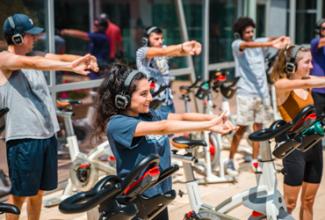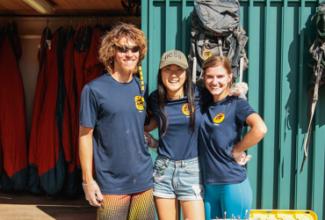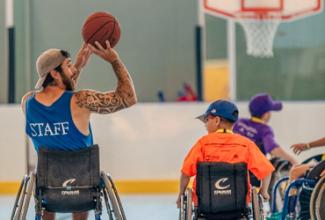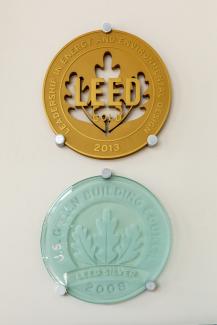Our Mission
The UCSB Department of Recreation serves our Gaucho community by cultivating well-being through our programs, services, and facilities.
Our Vision
To engage and inspire our Greater Gaucho community to thrive, have fun, and belong.
Our Core Values
Inclusion

Student-Focus

Enrichment

Our Commitment to Diversity, Equity, & Inclusion
The University of California community and the Department of Recreation values diversity, embraces inclusion, and honors excellence. Teaching, scholarship, research, creativity, innovation, and service flourish when all members of the community are welcomed, supported, and respected. Our work continues to fulfill these values. We are committed to removing barriers preventing full expression of our potential and to reflecting the population of California in our staff, especially those who have been systematically and historically underrepresented. Learn more about our commitment here.
History
The UCSB Recreation Center opened in 1995 with 100,000 sq. ft. and has been one of the most popular spots on campus ever since. The original Rec Cen has two swimming pools, two gymnasia, two weight rooms, two squash courts, and five racquetball courts. The Rec Cen Expansion (Rec Cen II) was approved by students in Spring 2000, opened in the Spring of 2005, and added 56,000 sq. ft. to the Rec Cen Complex. The expansion includes an additional weight room, multi-activity court (MAC), climbing center, spa, pottery studio, classroom, and additional locker facilities.
Sustainability
When applied to the area of building design and function, the term “sustainability” refers to environmentally responsible structures and resource efficiency. Thanks to the trail blazed by UCSB Department of Recreation and the Recreation Center, university recreation centers across the nation are moving in the direction of sustainability. The “Rec Cen” (as it is known to students) has broken barriers in terms of energy efficiency, and has paved the way for green recreation centers everywhere. Unbeknownst to most Gauchos, in 2008 the Rec Cen was the first recreation center in the United States to be awarded a LEED (Leadership in Energy and Environmental Design) Silver Certification for an Existing Building by the U.S. Green Building Council. In December 2013, the Rec Cen achieved an even more impressive LEED Gold Certification, making it the first and only university recreation center in the nation to receive such distinctions.

Click the links below to learn more about our commitment to sustainability.
Beginning in 2006, Assistant Director for Facilities, Bruce Hansen, and former Assistant Director for Recreation, Gary Jurich, spearheaded the structural changes that led to the Recreation Center’s first LEED Certification in 2008.
UCSB’s Recreation Center, which serves a vast majority of the school’s students on a regular basis, does so by largely sustainable means. Sustainable functions of the Recreation Center include:
Photovoltaic Array
Informally known as solar paneling, the 115 kW PV array covers the roof of the Multi-Activity Center and supports 80% of that building’s energy. It is the largest photovoltaic array on UCSB’s campus, generating 686,000 kWh of electricity annually.
Varied Frequency Drive Pumps
These circulate water in the Rec Cen pools according to the time of day, based on the given number of people in the pool for that time, rather than simply pumping full-blast at all hours of the day.
Much of the Rec Cen’s sustainability, however, results from simple practices and unseen functions. For instance, covers are kept on the pools overnight to keep temperatures from dropping too low in order to save energy on heating during the day, and washable cloth towels have replaced paper towels in weight rooms. Low-flow urinals and dual-flush toilets keep restrooms from using an excess of water, and the recently turfed Robertson Field demands virtually zero upkeep except its lighting at night. The majority of the facilities’ lighting uses LEDs (light-emitting diodes), and employee workstations feature motion-sensor lighting to avoid the waste of energy that results from lights left on after hours. In addition, the Rec Cen equips all of its employees with thermos-style water containers for hot and cold drinks to limit the use of disposable cups in the workplace. The Rec Cen not only contributes to the sustainable practices of UCSB's campus, but also helps spread sustainable practices to the people that it serves.
In 2008, UCSB’s Rec Cen became the first recreation center (college or otherwise) to earn a LEED Certification for an Existing Building. LEED stands for Leadership in Energy and Environmental Design, and certifications are awarded by the United States Green Building Council. The Department of Recreation at UCSB had begun striving toward sustainability in its facilities in 2006 as a result of a campus-wide push, led by Campus Sustainability Director Perrin Pellegrine. By 2008, the Rec Cen had improved by such leaps and bounds in sustainable practices that it received a LEED Silver Certification. Measures that led to this recognition included the institution of a recycling program, the removal of paper towels from weight rooms, and the aforementioned aquatic pumping practices. In 2013, the Rec Cen furthered its prominence among sustainable recreation centers by receiving a LEED Gold certification. The Gold came as a result of maintaining the practices that had gone into earning a Silver, with the addition of the MAC’s photovoltaic array. The Rec Cen was the first recreation center in the nation to receive a Gold Certification, and has since been awarded a Gold Certification by the California Central Coast chapter of the Green Building Council.
Moving forward with considerable momentum, pioneers Gary Jurich and Bruce Hansen have their sights set on a Platinum Certification and the concept of a net zero facility. When applied to green building, net zero refers to a structure that doesn’t use any more energy than it creates. The Multi-Activity Center already operates very close to net zero, and the replacing of every single one of its lights with LED lighting will put it even closer. Other resources that the Rec Cen is looking into include a solar pre-heating system for pool water that would reduce the energy used to heat the pool, and another photovoltaic array, either on the roof of the Rec Cen’s main building or at an offsite location. In the words of Recreation Center Manager Bruce Hansen, “We are constantly working to improve the culture and environment of sustainability here.”
View the UCSB Recreation Center's solar panels in action here.